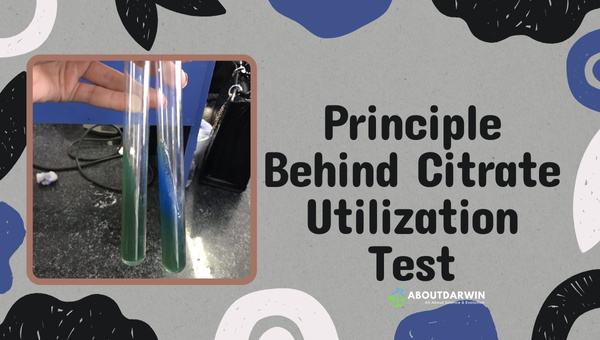Physical Address
304 North Cardinal St.
Dorchester Center, MA 02124
Are you curious about how Microbiologists differentiate bacteria based on their metabolic characteristics? Our comprehensive guide on the citrate utilization test will quench your curiosity.
We offer an in-depth exploration of this critical laboratory process. You will learn the principle behind the test, how to prepare for it, and how to interpret its results.
The citrate utilization test is a simple yet essential tool in microbiology that allows for bacterial differentiation based on their ability to utilize citrate as a carbon source.
Performed on Simmons Citrate Agar medium, the test highlights bacteria that possess a specific enzyme called citrate, enabling them to thrive exclusively on sodium citrate present in the media.
Contents
The Citrate Utilization test attempts to identify and differentiate different types of bacteria based on their ability to use citrate as a sole carbon source.

This test is critical for determining the metabolic activities of various bacterial species, helping with identification and further study.
The working principles of the Citrate Utilization Test center around the bacterium’s capacity to metabolize citrate. In simpler terms:
This method helps scientists or lab technicians understand whether specific bacterial strains are able to utilize citrates or not.
Understanding how this test works involves recognizing some crucial components and their roles:
This specialized growth medium has Sodium Citrate as its main carbon source, while ammonium dihydrogen phosphate serves as its nitrogen source. This interaction checks whether bacteria can utilize sodium citrate. Its utilization forms ammonium hydroxide, which increases Agar’s pH.
This is a pH indicator embedded into Simmon’s Citrate Agar, starting green at neutral pH but turning blue when conditions become alkaline (citrate action).
Depending upon their capacity for growth on Simmon’s Citrate Agar, they are classified as either Citrate-negative or positive.
In summary, a simple but effective principle allows researchers to classify and differentiate bacteria based on their ability (or lack thereof) to utilize citrate as a food source.
Simmons Citrate Agar is a specialized medium used in the citrate utilization test. Its purpose is to differentiate bacteria based on their ability to utilize citrate as a sole source of carbon.
Here’s a breakdown of its various components:
| Component | Role |
|---|---|
| Sodium citrate | It is the sole carbon source that can be utilized by bacteria capable of transporting it through their cell membrane. |
| Ammonium dihydrogen phosphate | The only source of nitrogen; its utilization leads to an alkaline reaction. |
| Dipotassium phosphate | Acts as a buffering agent and helps resist pH changes. |
| Magnesium sulfate heptahydrate | Supplies essential cations. |
| Agar | Solidifying agent. |
| Bromthymol blue | pH indicator, turns from green( neutral) to blue(basic) when bacteria utilize citrate. |
Preparing Simmons Citrate Agar involves several steps, which are mentioned below:
This prepared media provides an environment that facilitates differentiation based on bacterial species’ ability or inability to metabolize sodium citrate.
The change in color from green-neutral-(pH7)-to-Prussian-blue-(pH7.-7) is interpreted as a positive indication for bacterial growth or in other words, the bacteria will grow only if it can utilize citrate.
Also Read: Sabouraud Dextrose Agar (SDA): Composition, Uses, and More
The Citrate Utilization Test offers a simplified yet definitive process for characterizing and identifying specific bacteria based on their ability or inability to utilize citrate as their sole carbon source.
Every step in this test is performed with utmost precision, devoid of any necessity for complex apparatus or specialist skills.
A few basic lab supplies are required to carry out the Citrate utilization test. Here are the essentials:
Do remember to conduct this experiment in a sterilized environment wearing your lab coat and gloves.
Let’s walk you through the concise steps involved in performing this vital microbiological procedure:
Step 1: Begin by sterilizing your inoculating loop in the flame of a Bunsen burner until it’s red hot, then allow it to cool down for some moments (to avoid killing the bacteria).
Step 2: Pick up some bacterial colonies from your culture with your sterilized loop.
Step 3: Streak these bacterial samples onto the surface of your Simmons Citrate Agar slant delicately – make sure not to go too deep, which could lead to puncturing or contaminating other layers.
Step 4: Securely cap off the slant and place it inside an incubator set at around 35–37°C.
Step 5: Let it incubate for about 24-48 hours, depending upon features and growth rates of involved bacteria species.
Once completed, you move forward to executing another vital part – analyzing results.
Also Read: Identification and Biochemical Testing of Streptococcus pyogenes
Interpreting the Citrate Utilization Test results involves observing both color changes and growth patterns on the medium.

The test uses Simmons Citrate Agar, which is green at the onset but may change color based on whether or not a bacterium utilizes citrate.
If a bacterium can utilize citrate as its sole carbon source, it produces an enzyme that breaks down the ammonia salts in the medium.
This process raises the pH, turning the medium from green to blue—a clear indication of a positive test result. Additionally, visible growth will appear on the slant.
If a bacterium cannot utilize citrate, there will be no sign of growth, and the medium will retain its original green color.
It’s crucial to mention that all tests should be observed under appropriate lighting conditions for accurate interpretations and should ideally be cross-referenced with results from other biochemical tests for effective bacterial differentiation and identification.
It’s noteworthy to know that this procedure involves dealing with live bacterial cultures and hence requires careful attention toward safety measures such as wearing gloves and lab coats throughout execution.
Also Read: Unlock Your Roots: Explore Free Genealogy Websites Today
The test is used to differentiate between bacteria based on their ability to use citrate as their only source of carbon.
No, not all types of bacteria can utilize citrate as a sole carbon source. Only certain species exhibit this trait.
Yes, the test is quite accurate and reliable for differentiating species such as those within the Enterobacteriaceae family.
Yes, standard laboratory procedures such as wearing lab coats, gloves, and eye protection should be followed when handling bacterial cultures.
Also Read: Uncovering the Best: GenealogyBank vs Newspapers.com
In this article, we delved into the science behind the Citrate Utilization Test, examining its founding principles, key components, and its procedure. This test plays an indispensable role in distinguishing between different bacteria based on their ability to utilize citrate as a sole carbon source or not.
Equipped with a tool like this, microbiologists can study microbial diversity even more closely and contribute valuable findings to the field of microbiology. The more intricate our tools for differentiating bacteria become, the better we will be at diagnosing and treating bacterial infections.